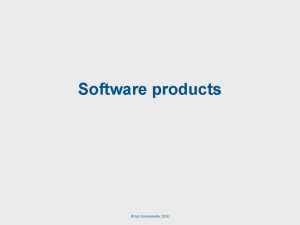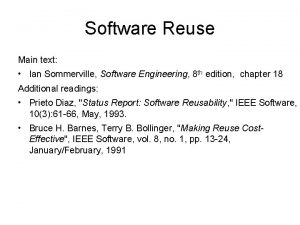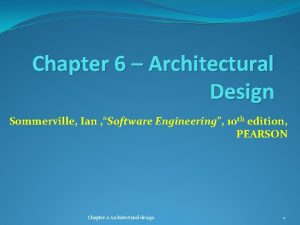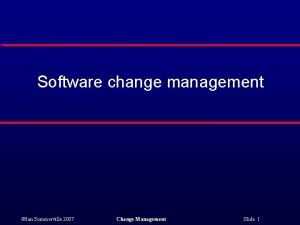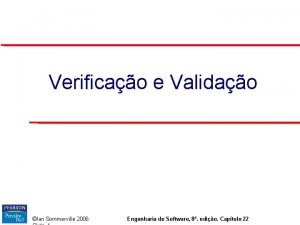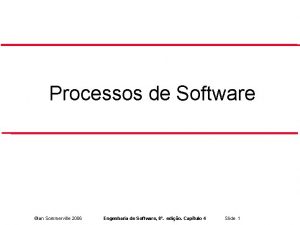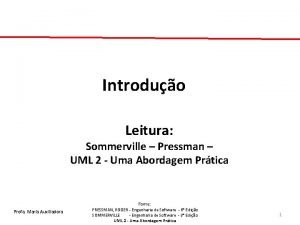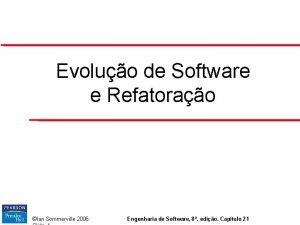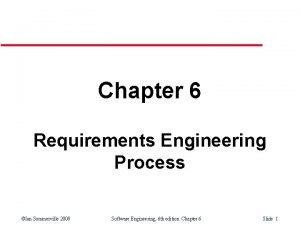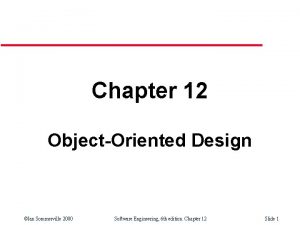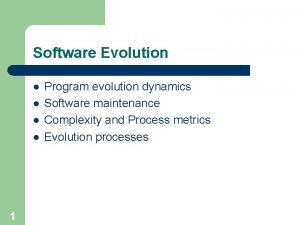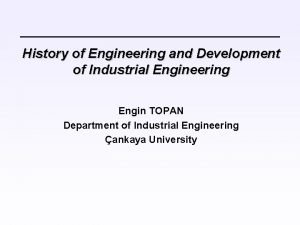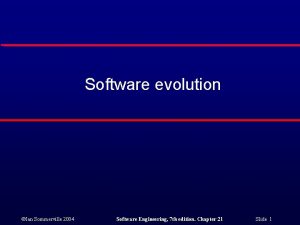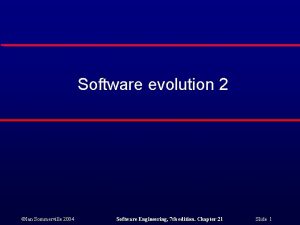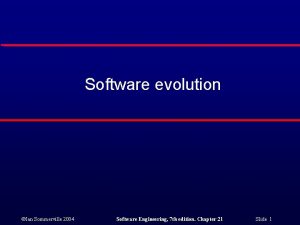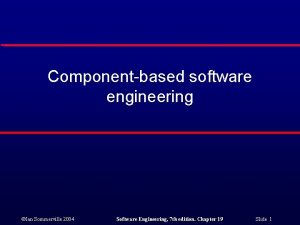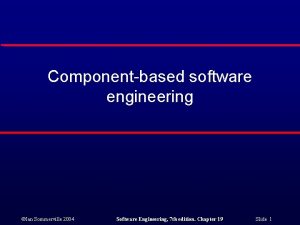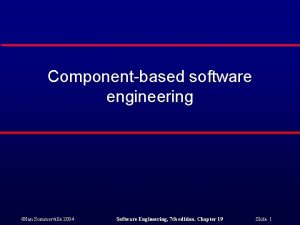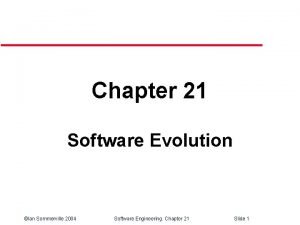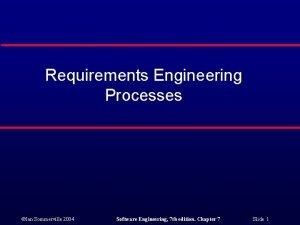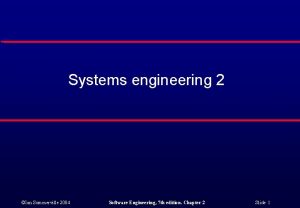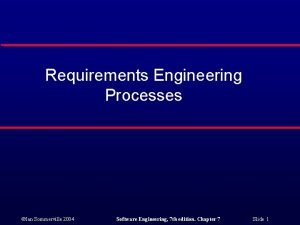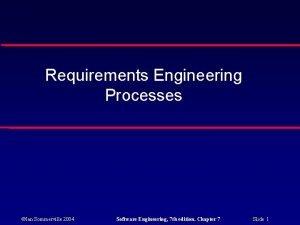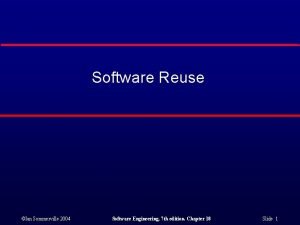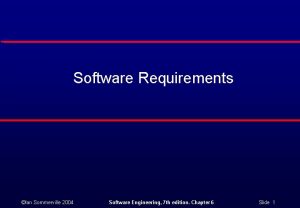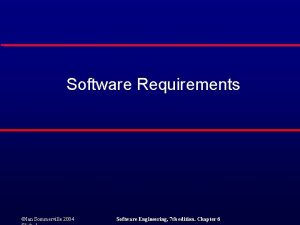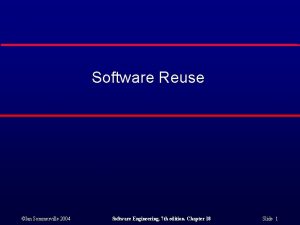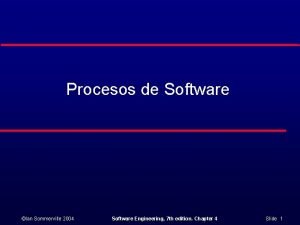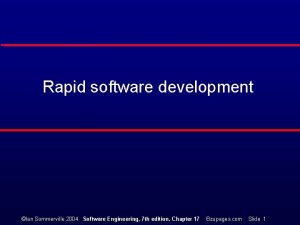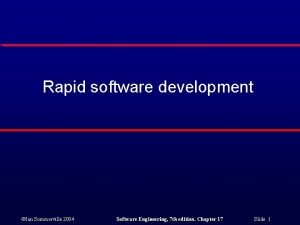Software evolution Ian Sommerville 2004 Software Engineering 7






















- Slides: 22

Software evolution ©Ian Sommerville 2004 Software Engineering, 7 th edition. Chapter 21 Slide 1

Topics covered l l Program evolution dynamics Software maintenance Complexity and Process metrics Evolution processes ©Ian Sommerville 2004 Software Engineering, 7 th edition. Chapter 21 Slide 2

Software change l Software change is inevitable • • • l New requirements emerge when the software is used; The business environment changes; Errors must be repaired; New computers and equipment is added to the system; The performance or reliability of the system may have to be improved. A key problem for organisations is implementing and managing change to their existing software systems. ©Ian Sommerville 2004 Software Engineering, 7 th edition. Chapter 21 Slide 3

Importance of evolution l l l Organizations have huge investments in their software systems - they are critical business assets. To maintain the value of these assets to the business, they must be changed and updated. The majority of the software budget in large companies is devoted to evolving existing software rather than developing new software. ©Ian Sommerville 2004 Software Engineering, 7 th edition. Chapter 21 Slide 4

Program evolution dynamics l l l Program evolution dynamics is the study of the processes of system change. After major empirical studies, Lehman and Belady proposed that there were a number of ‘laws’ which applied to all systems as they evolved. There are sensible observations rather than laws. They are applicable to large systems developed by large organisations. Perhaps less applicable in other cases. ©Ian Sommerville 2004 Software Engineering, 7 th edition. Chapter 21 Slide 5

Lehman’s laws ©Ian Sommerville 2004 Software Engineering, 7 th edition. Chapter 21 Slide 6

Applicability of Lehman’s laws l Lehman’s laws seem to be generally applicable to large, tailored systems developed by large organisations. • l Confirmed in more recent work by Lehman on the FEAST project (see further reading on book website). It is not clear how they should be modified for • • Shrink-wrapped software products; Systems that incorporate a significant number of COTS components; Small organisations; Medium sized systems. ©Ian Sommerville 2004 Software Engineering, 7 th edition. Chapter 21 Slide 7

Software maintenance l l l Modifying a program after it has been put into use. Maintenance does not normally involve major changes to the system’s architecture. Changes are implemented by modifying existing components and adding new components to the system. ©Ian Sommerville 2004 Software Engineering, 7 th edition. Chapter 21 Slide 8

Maintenance is inevitable l l l The system requirements are likely to change while the system is being developed because the environment is changing. Therefore a delivered system won't meet its requirements! Systems are tightly coupled with their environment. When a system is installed in an environment it changes that environment and therefore changes the system requirements. Systems MUST be maintained therefore if they are to remain useful in an environment. ©Ian Sommerville 2004 Software Engineering, 7 th edition. Chapter 21 Slide 9

Types of maintenance l Maintenance to repair software faults • l Maintenance to adapt software to a different operating environment • l Changing a system to correct deficiencies in the way meets its requirements. Changing a system so that it operates in a different environment (computer, OS, etc. ) from its initial implementation. Maintenance to add to or modify the system’s functionality • Modifying the system to satisfy new requirements. ©Ian Sommerville 2004 Software Engineering, 7 th edition. Chapter 21 Slide 10

Distribution of maintenance effort ©Ian Sommerville 2004 Software Engineering, 7 th edition. Chapter 21 Slide 11

Maintenance costs l l Usually greater than development costs (2* to 100* depending on the application). Affected by both technical and non-technical factors. Increases as software is maintained. Maintenance corrupts the software structure so makes further maintenance more difficult. Ageing software can have high support costs (e. g. old languages, compilers etc. ). ©Ian Sommerville 2004 Software Engineering, 7 th edition. Chapter 21 Slide 12

Development/maintenance costs ©Ian Sommerville 2004 Software Engineering, 7 th edition. Chapter 21 Slide 13

Maintenance cost factors l Team stability • l Contractual responsibility • l The developers of a system may have no contractual responsibility for maintenance so there is no incentive to design for future change. Staff skills • l Maintenance costs are reduced if the same staff are involved with them for some time. Maintenance staff are often inexperienced and have limited domain knowledge. Program age and structure • As programs age, their structure is degraded and they become harder to understand change. ©Ian Sommerville 2004 Software Engineering, 7 th edition. Chapter 21 Slide 14

Complexity metrics l l l Predictions of maintainability can be made by assessing the complexity of system components. Studies have shown that most maintenance effort is spent on a relatively small number of system components. Complexity depends on • • • Complexity of control structures; Complexity of data structures; Object, method (procedure) and module size. ©Ian Sommerville 2004 Software Engineering, 7 th edition. Chapter 21 Slide 15

Process metrics l Process measurements may be used to assess maintainability • • l Number of requests for corrective maintenance; Average time required for impact analysis; Average time taken to implement a change request; Number of outstanding change requests. If any or all of these is increasing, this may indicate a decline in maintainability. ©Ian Sommerville 2004 Software Engineering, 7 th edition. Chapter 21 Slide 16

Evolution processes l Evolution processes depend on • • • l The type of software being maintained; The development processes used; The skills and experience of the people involved. Proposals for change are the driver for system evolution. Change identification and evolution continue throughout the system lifetime. ©Ian Sommerville 2004 Software Engineering, 7 th edition. Chapter 21 Slide 17

Change identification and evolution ©Ian Sommerville 2004 Software Engineering, 7 th edition. Chapter 21 Slide 18

The system evolution process ©Ian Sommerville 2004 Software Engineering, 7 th edition. Chapter 21 Slide 19

Change implementation ©Ian Sommerville 2004 Software Engineering, 7 th edition. Chapter 21 Slide 20

Urgent change requests l Urgent changes may have to be implemented without going through all stages of the software engineering process • • • If a serious system fault has to be repaired; If changes to the system’s environment (e. g. an OS upgrade) have unexpected effects; If there are business changes that require a very rapid response (e. g. the release of a competing product). ©Ian Sommerville 2004 Software Engineering, 7 th edition. Chapter 21 Slide 21

Emergency repair ©Ian Sommerville 2004 Software Engineering, 7 th edition. Chapter 21 Slide 22
 Engineering software products ian sommerville
Engineering software products ian sommerville Simple aspect example
Simple aspect example Inżynieria oprogramowania ian sommerville
Inżynieria oprogramowania ian sommerville Sommerville software engineering slides
Sommerville software engineering slides Change management in software testing
Change management in software testing Sommerville
Sommerville Sommerville
Sommerville Sommerville
Sommerville Uml 2 uma abordagem prática
Uml 2 uma abordagem prática Sommerville
Sommerville Sommerville
Sommerville Sommerville
Sommerville Elaine sommerville
Elaine sommerville Damian sommerville
Damian sommerville Program evolution dynamics
Program evolution dynamics System architecture example
System architecture example Forward engineering and reverse engineering
Forward engineering and reverse engineering Industrial engineering formal definition
Industrial engineering formal definition Software maintenance process models ppt
Software maintenance process models ppt What is software implementation in software engineering
What is software implementation in software engineering What is software metrics in software engineering
What is software metrics in software engineering Example of software crisis
Example of software crisis Software measurement and metrics in software engineering
Software measurement and metrics in software engineering
